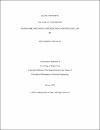| الملخص | Wireless LAN (also called as Wi-Fi) is dominantly considered as the most pervasive
technology for Intent access. Due to the low-cost of chipsets and support for high data
rates, Wi-Fi has become a universal solution for ever-increasing application space
which includes, video streaming, content delivery, emergency communication,
vehicular communication and Internet-of-Things (IoT).
Wireless LAN technology is defined by the IEEE 802.11 standard. The 802.11
standard has been amended several times over the last two decades, to incorporate the
requirement of future applications. The 802.11 based Wi-Fi networks are
infrastructure networks in which devices communicate through an access point.
However, in 2010, Wi-Fi Alliance has released a specification to standardize direct
communication in Wi-Fi networks. The technology is called Wi-Fi Direct. Wi-Fi
Direct after 9 years of its release is still used for very basic services (connectivity, file
transfer etc.), despite the potential to support a wide range of applications. The reason
behind the limited inception of Wi-Fi Direct is some inherent shortcomings that limit
its performance in dense networks. These include the issues related to topology
design, such as non-optimal group formation, Group Owner selection problem,
clustering in dense networks and coping with device mobility in dynamic networks. Furthermore, Wi-Fi networks also face challenges to meet the growing number of Wi
Fi users. The next generation of Wi-Fi networks is characterized as ultra-dense
networks where the topology changes frequently which directly affects the network
performance. The dynamic nature of such networks challenges the operators to design
and make optimum planifications.
In this dissertation, we propose solutions to the aforementioned problems. We
contributed to the existing Wi-Fi Direct technology by enhancing the group formation
process. The proposed group formation scheme is backwards-compatible and
incorporates role selection based on the device's capabilities to improve network
performance. Optimum clustering scheme using mixed integer programming is
proposed to design efficient topologies in fixed dense networks, which improves
network throughput and reduces packet loss ratio. A novel architecture using
Unmanned Aeriel Vehicles (UAVs) in Wi-Fi Direct networks is proposed for
dynamic networks. In ultra-dense, highly dynamic topologies, we propose cognitive
networks using machine-learning algorithms to predict the network changes ahead of
time and self-configuring the network. |


